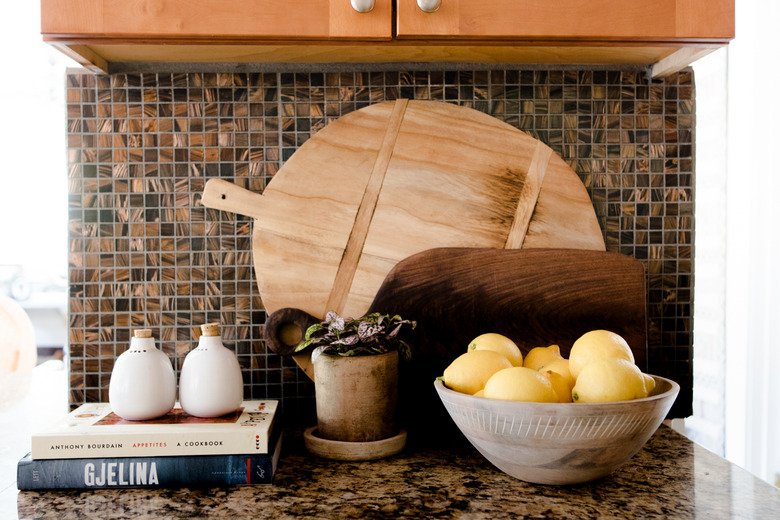Stone Countertop Repair: What You Should Know
Given what they cost, it's absolutely nauseating to find a chip or crack in your stone countertop. Fear not, however, as discreet stone countertop repair is not only attainable but likely something you can do yourself. If you find a problem with your counter, all you need are a few antacids and a trip to the hardware store to feel better and fix the problem.
Is This a DIY Repair?
Is This a DIY Repair?
Stone repair is a fairly simple DIY project if you're dealing with a small scratch or chip. There are times, however, when it's best to go with a pro. One such time is when you're working in an area where your counter lacks support. If you have an overhang or another area where your countertop may not have as much support underneath it (like around your sink, for example), it's best to call in a professional to make the repair.
Very large chips are also best left to the pros. You can get away with a clear or close-enough epoxy color match with small chips, but larger areas will prove more noticeable if you don't get the color just right. Have a friend or family member come over and look at your counter. If it takes them a while to find the chip, you can likely repair it yourself. If they spot it instantly, call a professional to repair it.
You may also want help if you've broken off a piece of stone from the edge or corner of your countertop. It's possible to reattach these pieces with some epoxy when they're whole, but reattaching them may leave voids if part of the stone chipped or crumbled away during the break. If you don't fill these gaps properly, your repair may be visible or lack the structural integrity to avoid breaking again in the future.
Things Needed
-
Stone countertop-repair kit
-
Denatured alcohol
-
Water
-
Paper bowl
-
Plastic spoon
-
Applicator (popsicle stick, putty knife)
-
Steel wool or 300-grit sandpaper
-
Sealer
-
150-grit sandpaper
How to Fix Stone Countertops
1. Find a Countertop-Repair Kit
Because chips, dings and scratches in natural-stone countertops are common, many different companies manufacture commercial stone-repair kits. Readily available in hardware stores and through countertop installers, these kits have everything you need to repair a chip or crack. The contents of each repair kit can vary a bit, but there are a few basic things for which you should look.
- Look for a repair kit that contains two different types of epoxy. The first is a thin, low-viscosity epoxy, and the second is a thicker, high-viscosity blend. You'll choose which viscosity to use based on the location of the repair.
- Choose a kit that includes
a chemical spray that hardens the epoxy when you're done with the repair. Some may include a small LED light to set the epoxy instead. - Although not strictly necessary, you may wish to opt for a kit that includes a small syringe that can help you get the epoxy into tight spaces and narrow cracks.
- In most cases, a clear epoxy will do the trick, allowing the natural color of the stone to show through. If desired, however, you can use a dye or tint to try and color-match the countertop more precisely. Getting the color right can involve a lot of trial and error, and getting it wrong can make your repair obvious. It's best to avoid it unless you're dealing with a very large chip in a conspicuous area.
2. Repair Surface Damage
Before making your repair, thoroughly clean the affected area of your countertop with a 50/50 mix of alcohol and water and allow it to dry. This ensures that the epoxy will bond well to the surface.
- Prepare the low-viscosity epoxy according to the instructions in your countertop repair kit. This usually involves mixing two chemicals together to activate them. To make cleanup easy, mix the epoxy in a small paper bowl using a plastic spoon. If you're using a dye, add it to your epoxy while you mix it.
- Apply the epoxy to your countertop, making sure you fill in the damaged area completely. You can do so using the syringe that came in your repair kit if applicable or by smoothing the epoxy into the groove using the edge of a credit card, putty knife, popsicle stick, razor blade or something similar. Be sure to fill the void completely, making it level with the rest of the countertop. When in doubt, overfill the chip rather than underfill it.
- Set the epoxy by spraying on the setting chemical in your repair kit or by shining the appropriate light onto it. You can also carefully rub away any excess epoxy with steel wool or 300-grit sandpaper, taking care not to scratch the countertop's finish.
- According to Countertop Investigator, you should immediately reapply a countertop sealer to the area you've repaired so stains don't creep into the stone.
3. Repair Edge Damage
Repairing cracks, chips and small gouges on the side or edge of your countertop involves the same process as repairing the top. You will, however, use a different epoxy. When repairing the top of the counter, you used the low-viscosity epoxy so that the material could seep into the counter as deeply as possible. You'll use the high-viscosity epoxy on the side of the counter to avoid drips and keep the epoxy where you want it.
- Clean the area with a mix of alcohol and water before you begin.
- Prepare the epoxy and then apply it to the crack or chip, smoothing it out and getting it as level as possible.
- Set the epoxy using the spray or light in your repair kit.
- Sand away any excess material with a fine-grit sandpaper.
4. Reattach Broken Edges
Granite countertops and others made of natural stone often break along their edges or at corners. Rounded edges help reduce the risk of these breaks, but accidents can still happen. If you still have the broken piece, you can repair the damage by using your high-viscosity epoxy as a glue rather than a filler.
- Lightly sand both the edge of the broken piece and the counter's edge with rough 150-grit sandpaper.
- Prepare a mixture of equal parts water and alcohol and use it to clean the surfaces you're bonding.
- Mix the high-viscosity epoxy in a disposable container and then spread a thin layer of it onto the edge of the counter and the broken piece. In this case, you'll want an epoxy that sets quickly since you'll have no way to access and cure the epoxy once it's sandwiched between the two pieces of the countertop.
- Carefully align the broken pieces and then firmly push them together. Hold the mended pieces of the countertop together until the epoxy is cured enough to support it or until you clamp or otherwise secure the piece. Holding the piece in place and clamping it into place may require more than two hands, so grab a friend to help you if you can.
- Even if your epoxy promises to cure quickly, it's best to leave your repair undisturbed for at least 72 hours, according to the Epoxy Network.
- Sand away any excess epoxy with 300-grit sandpaper after it has fully cured.

